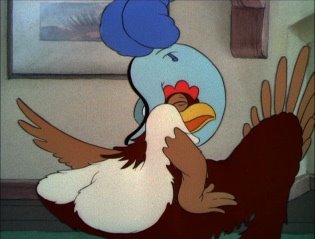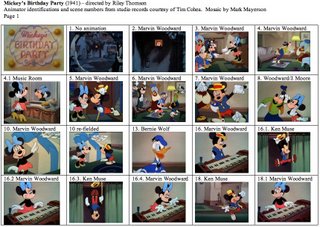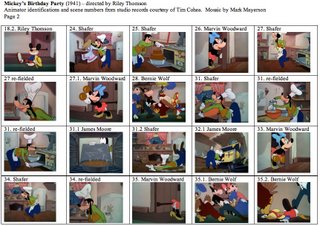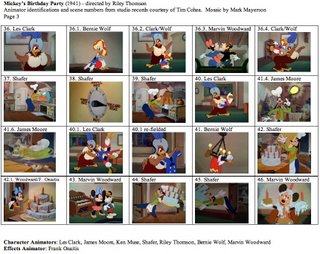

A fan/historian going under the internet handle The Spectre pointed out that the draft for Mickey's Birthday Party lists the Music Room as responsible for the majority of footage in the two Mickey Mouse dance sequences. Ken Muse is credited with a small amount of footage for the first scene and Riley Thomson a small amount of footage for the second. Footage attributed to the Music Room (which was really the director's room) means that the scene either had no animation or had existing animation lifted from another film.
When I did the mosaic for the film, I definitely didn't look closely enough at the draft and assumed that the credited animators were responsible for the whole thing.

In comments when I printed the mosaic, Galen Fott said that he had a drawing of Mickey that he was told was from Mickey's Surprise Party, which was a commercial that the Disney studio made for Nabisco for use at the 1939 World's Fair. Galen's drawing matches the costuming of Mickey in that cartoon, but there is no dance animation in it. Furthermore, the pose in Galen's drawing matches a frame in Mickey's Birthday Party pretty closely.
At this point, I do believe that the dance animation pre-existed Mickey's Birthday Party, but there are several unanswered questions. Was the animation originally done for Mickey's Surprise Party and cut from the film for some reason? If not, what film was the footage done for? Finally, who animated this great dance? It always looked like Ward Kimball to me before I got a look at the draft. Is it Kimball? Fred Moore? Of course, it's possible that Muse and Thomson animated the scenes for an earlier film and then added some new material to make it fit into the new film.
If there is anybody out there who can shed some light on this mystery, I'd love to hear from you.







